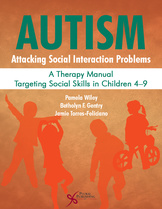Publication

Autism: Attacking Social Interaction Problems
A Therapy Manual Targeting Social Skills in Children 4-9
- Co-Authors: Pamela Wiley, Betholyn F. Gentry, Jamie Torres-Feliciano
- Details:
- 392 pages, Illustrated (B/W), Softcover, 8.5 x 11"
- ISBN13:
- 978-1-59756-792-3
- Release Date:
- 09/30/2015
Overview
Autism: Attacking Social Interaction Problems: A Therapy Manual Targeting Social Skills in Children 4-9 includes sample parent letters, teacher letters, weekly skill steps, and simple stories to reinforce the information presented in the text as well as suggestions for extension activities. The AASIP program provides a comprehensive yet practical approach to teaching social communication skills across the life span to individuals with moderate to high functioning autism spectrum disorder and other diagnoses that result in social communication deficits. Children will enjoy engaging with their peers as they learn how to become social communicators and build their confidence.
This user-friendly workbook includes 16 chapters divided into two units for children 4-6 and 7-9 years of age, allowing flexibility to select activities from either age group depending on the needs of the children. These lessons can be easily used in school settings as well as clinical settings.
The AASIP program offers three additional books for children ages 10-12, the teen years, and a pre-vocational training manual for individuals 17 years to adulthood.
- Autism: Attacking Social Interaction Problems: A Therapy Manual Targeting Social Skills in Children 10-12
- Autism: Attacking Social Interaction Problems: A Therapy Manual Targeting Social Skills in Teens
- Autism: Attacking Social Interaction Problems: A Pre-Vocational Training Manual for Ages 17+
Review
Brenda L. Beverly, Ph.D., CCC-SLP (University of South Alabama), Doody's (September 2016):
"The book presents detailed lesson plans with suggested goals and activities for a wide variety of social skills. The book addresses skills such as identifying others' emotions, participating in games and sports, listening and following directions for school and social settings, friendships, social outings, and stranger danger rules. Highlights of the book include suggestions for incorporating structure and routine in the Getting Started section, and the summary skill steps in each section (e.g., five steps for asking to join play or six steps for asking for help)."
Preface
Acknowledgments
Chapter 1. Introduction
Chapter 2. Getting Started: Creating a Program
Chapter 3. Weekly Rituals
Unit I. Activities for 4- to 6-Year-Olds
Chapter 4. The ABCs of Life: Skills Needed for School Success
- Lesson 1. Active Listening
Lesson 2. Following Directions
Lesson 3. Asking for Help
Chapter 5. How Are You Today? Dealing with Emotions
- Lesson 1. Identifying Our Emotions
Lesson 2. Recognizing Emotions in Others
Lesson 3. The Right Emotion for the Right Situation
Chapter 6. Taking the First Step: Initiating Friendships
- Lesson 1. Introducing Myself
Lesson 2. Initiating and Ending a Conversation
Lesson 3. Sharing is Caring
Chapter 7. Let the Games Begin: Being a Good Sport
- Lesson 1. Asking to Play
Lesson 2. Taking Turns
Lesson 3. Winning, Losing, Compromising
Chapter 8. It's Raining Cats and Dogs: Figurative Language
- Lesson 1. Understanding Idioms and Common Expressions
Chapter 9. Grossology: Personal Hygiene
- Lesson 1. First Impressions
Lesson 2. No More Gross
Lesson 3. The Unfriendly Germs
Chapter 10. Blending In: Everyday Situations
- Lesson 1. Eating Out
Lesson 2. Birthday Party
Lesson 3. A Visit to the Dentist and Doctor
Chapter 11. Stranger Danger: Being Safe
- Lesson 1. Who's a Stranger?
Lesson 2. Appropriate Versus Inappropriate Touching
Unit II. Activities for 7- to 9-Year-Olds
Chapter 12. The ABCs of Life: Skills Needed for School Success
- Lesson 1. Active Listening
Lesson 2. Following Directions
Lesson 3. Asking for Help
Chapter 13. How Are You Today? Dealing with Emotions
- Lesson 1. Identifying Our Emotions
Lesson 2. Recognizing Emotions in Others
Lesson 3. The Right Emotion for the Right Situation
Chapter 14. Taking the First Step: Initiating Friendships
- Lesson 1. Who Should Be Your Friend
Lesson 2. How to Be a Good Friend
Lesson 3. Topic Maintenance
Chapter 15. Let the Games Begin: Being a Good Sport
- Lesson 1. Asking to Play
Lesson 2. Taking Turns
Lesson 3. Winning, Losing, Compromising
Chapter 16. It's Raining Cats and Dogs: Figurative Language
- Lesson 1. Understanding Idioms and Common Expressions
Lesson 2. Using Idiomatic Expressions
Chapter 17. Grossology: Personal Hygiene
- Lesson 1. First Impressions
Lesson 2. No More Gross
Lesson 3. The Unfriendly Germs
Chapter 18. Blending In: Everyday Situations
- Lesson 1. Eating Out
Lesson 2. Birthday Party
Lesson 3. Routines
Chapter 19. Stranger Danger: Being Safe
- Lesson 1. Who's a Stranger
Lesson 2. Appropriate Versus Inappropriate Touching
Appendix A. Sample Parent Letters
Appendix B. Sample Teacher Letter
Appendix C. Sample Skill Steps
Appendix D. Sample Newsletter
Appendix E. Sample Data Tracking Form 1
Appendix F. Sample Data Tracking Form 2
References
Related Titles
Autism: Attacking Social Interaction Problems
Co-Authors: Betholyn F. Gentry, Pamela Wiley
176 pages, Illustrated (B/W), Softcover, 8.5 x 11"
Educating Students with Autism Spectrum Disorder
Joshua K. Harrower, Louis G. Denti, Marcia Weber-Olsen
245 pages, Illustrated (B/W), Softcover, 7 x 10"
Autism: Attacking Social Interaction Problems
Co-Authors: Betholyn F. Gentry, Pamela Wiley, Jamie Torres-Feliciano
252 pages, Illustrated (B/W), Softcover, 8.5 x 11"
Autism: Attacking Social Interaction Problems
Co-Authors: Pamela Wiley, Betholyn F. Gentry
296 pages, Illustrated (B/W), Softcover, 8.5 x 11"
Here's How to Provide Intervention for Children with Autism Spectrum Disorder
Catherine B. Zenko, Michelle Peters Hite
184 pages, Illustrated (B/W), Softcover, 8.5 x 11"
Parenting on the Autism Spectrum
224 pages, Illustrated (B/W), Softcover
-












